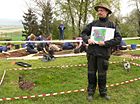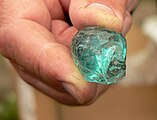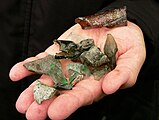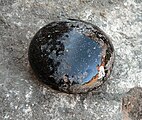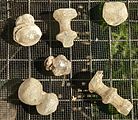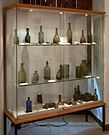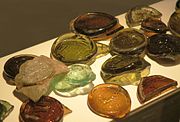Klein Süntel glassworks
The Klein Süntel glassworks was a modern glassworks, first mentioned in a document around 1620, on the south-eastern slope of the Süntel in Klein Süntel , a current district of Bad Münder in Lower Saxony . It was destroyed and rebuilt several times in its 250-year history, so that production was not continuous, but was characterized by many interruptions. Until it was shut down in 1886 , the smelter produced green glass , which was exported as hollow glass in the form of bottles in large numbers to America . It is considered to be the earliest establishment of seven glassworks in the Deister-Süntel and Osterwald regions in Lower Saxony. Because of their importance for regional and industrial history, the remains of the glassworks have been archaeologically researched since 2011 .

Location and buildings
At that time, an elevated and exposed area on the south-east slope of the Süntel was chosen as the location of the glassworks. The strong winds up high served to supply air for the fire to melt the glass. For this purpose, in Klein Süntel, as in other glassworks, there were bricked poking channels under the ground, which the archaeological investigations to date have shown. In the vicinity of the village, coal mining was carried out in the Süntel . According to tradition, the mined coal was used in the glassworks as an energy source for glass melting from the 1830s, but possibly as early as the 17th century. There was a brick factory in the immediate vicinity of the glassworks .
A glassworks structure that still exists today is a former production building directly on the main road in Klein Süntel. It was later the home of the respective glassworks owner and was converted into a mansion around 1820 . Since 1982 it has served as an administrative wing for the adjoining senior citizens' residence , which was built in the 1980s on the former glassworks site.
Although one or two glassworks with several manufacturing buildings in the area can be assumed, no other structures have been preserved above ground. On the other hand, remains of systems can still be found in the ground, as the previous archaeological investigations have shown. The remains of a glassworks building discovered under a grassy hill correspond to a description in the Chronicle of Flegessen , according to which the Hamelin merchant Johann Eduard Hentig built a new glassworks in this area in 1820 on an earlier slag heap, which was in operation until 1886. A stone horse stable of the hut complex was demolished around the 1980s. These stones have recently been used for a decorative flower ring at this point.
history
According to more recent findings, a glassworks in Klein Süntel was first mentioned around 1620, according to the earlier state of knowledge, not until 1638. Location factors for operating a glass factory at this location were the availability of raw materials such as wood and coal from the Süntel , quartz sand for the glass, Sandstone for the construction of the furnace and clay for the glass harbors as melting vessels. There were often delivery bottlenecks for salt and potash .
According to written tradition, at the beginning of the Thirty Years' War (1618–1648), acts of war in the Bad Münder area led to the destruction of the hut, so that glass production was stopped. Previously there were supposed to have been attempts to use hard coal from the Süntel instead of wood to melt glass, which was still a problematic technology at the time. The hut was not rebuilt until 1680. In 1718 another glassworks was built in Klein Süntel, which was damaged twice by the French during the Seven Years' War - around 1760. At that time the hut consisted of an upper and a right glassworks and a residential building. Since the buildings were in poor condition, they were replaced by a new building with outbuildings in 1769.
During the 250-year existence of the glassworks in Klein Süntel, there was no uninterrupted glass production. There were long interruptions due to frequent changes of ownership, over-indebtedness, war events, insufficient raw material supply and technical problems. There were long periods of inactivity, especially during the 17th and early 18th centuries; temporarily because of the stalled coal mining in the Süntel. Permanent production did not start until 1755, and after a further break again from 1815 when the Hamelin merchant Johann Eduard Hentig took over the works. At that time the company consisted of the glassworks building, the glass warehouse, the glass master's apartment, a stable, an outbuilding and a residential building. In 1820 a new glassworks was built on the former slag heap, which is likely to be the remains of the building that had been archaeologically examined up to now.
There were other glassworks in the region in the former places Münder (Süntelgrund and Münder), Osterwald ( Lauensteiner Glas ), Steinkrug ( Steinkrug glassworks ), Hemmendorf (Hemmendorfer Dreisch) and Oldendorf (In der Sümpelbreite).
production

The hut was founded at the beginning of the 17th century to produce glass for use (at that time mainly green glass in the form of bottles). In contrast, there was the Lauensteiner glass from the Osterwald glassworks in the same region . It produced fine glass for the Hanoverian court and the Electorate of Hanover . For the Klein Süntel glassworks, bottles were the main product throughout its production time. These include above all Hanoverian bottles that had a seal with the Guelph Horse. In the middle of the 18th century, the hut presumably held the monopoly of the Electorate of Hanover for these bottles . In the 18th century, the bottles gradually got a glass seal that identified the glassworks or the respective manufacturer as the manufacturer. This was done on a sovereign order because of the increasing fraud caused by the production of bottles that were too small. For example, the labels on the Klein Sünteler Hütte seal read GL. FAB. A. Suntel (Glasfabrik am Suntel) around 1780 or Suntelsche GL.H. (Suntelsche Glashütte) around 1800. An electoral decree of 1771 also required the hut to use the initials GR for Georg Rex in the seal as a national emblem , which was in use until 1818. Individual bottles from the production of the Klein Süntel glassworks are exhibited today in the Gernheim glassworks or are owned by members of the Forum Glas association, which was founded in 2006 and is based in Bad Münder .
In the 19th century, the glassworks also produced medicine bottles on a large scale. Flat glass was made to a lesser extent and to order ; also preserving jars as well as schnapps and beer bottles. As the manufacturing method, there was only in the early days of glass making by mouth blow, later pressed glass made. In its most productive times in the mid-19th century, the hut produced up to 350,000 bottles and 500,000 medicine bottles a year. Around 1880, utility glass was mainly produced in cobalt blue .
Sales areas for glass production were Braunschweig, Bremen, Hanover, Magdeburg, Nordhausen, Saxony , East Friesland and the Netherlands . Often the entire annual production was delivered to certain partners on the basis of purchase agreements. Bottles for bottling medicinal water were produced in Pyrmont in large numbers , or they were shipped to North and South America via Bremen and the Netherlands.
Owners and staff
The owners and tenants of the glassworks changed frequently, which impaired long-term production. In the 19th century alone there were around ten different operators. In 1810 the glass works leaseholder Conrad Storm left the lease contract after 17 years due to discrepancies. In 1799 he founded the “Schauenstein glassworks” in Obernkirchen , which later belonged to the Heye glassworks and more recently joined the Ardagh Group . The workforce in Klein Süntel consisted of an average of 20 to 30 people. Among them were a master and up to 12 journeymen . In the middle of the 19th century there were up to 20 glassmakers . Other employed persons were women and mostly young people who were unpaid. Around 1834/35, the mountain master Christian Rave produced Bouteille glass with his widow Hentig in the glassworks .
Archaeological research
Discovery 2011
On the site of the former glassworks, an underground passage was discovered in September 2011 during excavation work. It is located under a 15 by 30 meter grassy mound ( 52 ° 10 ′ 3.7 ″ N , 9 ° 26 ′ 21.7 ″ E ) next to the retirement home and the building of the local volunteer fire department . The corridor is six meters long, 2.5 meters high and two meters wide. It no longer has the original length, as it was later walled up with rubble stones at both ends . After the survey by a monument conservationist , the entrance to the corridor was secured with a control shaft. At first it was assumed that it was an earlier stoke channel for ventilation or the feeding tunnel of the glassworks.
The association Forum Glas from Bad Münder, which promotes the history of glass in the Deister-Süntel region, received the project management including an excavation permit for the site from the district of Hameln-Pyrmont as the lower monument protection authority. The Lower Saxony State Office for Monument Preservation (NLD) as the upper monument authority classified the site as a ground monument and placed it under monument protection by including it in the list of monuments . In the absence of financial resources of its own, the NLD recommended geophysical prospecting measures to the association for further exploration , which do not interfere with the ground and prove to be inexpensive.
Prospecting 2012
The Forum Glas association commissioned the forensic archaeologist Roland Wessling from the British University of Cranfield , who comes from the Süntel region, to carry out the investigations. They took place on an area of 40 × 40 meters in spring 2012 using georadar and geoelectrics . As a result, walls and cavities emerged on the floor pictures from the ground of the grass hill, which were very similar to those of the Gernheim glassworks . Since the structures seen in the ground are very likely to be the remains of an old glassworks building, the Forum Glas Association decided to carry out a test excavation in autumn 2012.
Excavation 2013

In the spring of 2013, a five-day excavation took place on the former glassworks site . It was carried out as a teaching excavation by 15 students on a master’s course in forensic archeology at the University of Cranfield under the direction of Roland Wessling and two other lecturers . The excavation technique involved a sighting or test excavation in which only small areas that were likely to be found were exposed in order to obtain information about the other structures in the ground. Most of the excavation costs of 10,000 euros were borne by the bingo! Environmental foundation and the Hameln-Pyrmont district.
Before the excavation, two flat ground cuts were made in the grass hill prospected in 2012. The intersecting, 30 meter long and one meter wide search cuts ran in north-south and east-west directions. At one point in the intersection area, a larger area of about 25 m² was excavated. There was a paving of red brick and brick walls just a few centimeters below the surface of the earth . Another discovery was a vault as a deep cavity, which, together with the passage discovered in 2011, represents a cross-like structure. This suggests poking passages with which drafts were introduced in order to increase the firing temperature when the glass was melted. It could also be the vaulted ceilings of the glass production chamber. In addition to glass and coal remains and large amounts of slag , two preserved glass bottles were also found. The bottles are a Schlegel bottle from around 1850 and a beer bottle from around 1870. A circular foundation of rubble stones could, according to an initial assumption by archaeologists at Cranfield University, represent the remainder of a glassworks tower about 10 meters in diameter. The archaeologists took individual finds back to Great Britain; there they were examined in terms of materials. After the excavation, the excavation area was covered with a fabric tarpaulin and then covered again with the original excavated soil. As a result, the uncovered areas of discovery remained protected and could easily be uncovered in a further excavation.
Archaeologist Roland Wessling presents the graphical result of the prospection using georadar and geoelectrics
Investigation of light-colored rubble stones, possible material of a glassworks tower
Excavation tour by Hermann Wessling from the Forum Glas Association on International Museum Day 2013
Excavation 2014
Since the excavation results available at the end of 2013 justify a further excavation phase, according to the archaeologist Roland Wessling, this was planned for 2014 and was financially secured as a one-week excavation. According to the plans, around a third of the glassworks should be exposed. The Bingo Environment Foundation has promised up to 50,000 euros for further investigations. In the five-day excavation around Easter 2014, 13 students from Cranfield University and, for the first time, members of a youth construction hut from Stade took part. The excavation area of the previous year was expanded and backfilled after completion.
Excavation 2015
In August 2015, another one-week excavation took place on the former glassworks site, which was carried out by an eight-person excavation team from Cranfield University under the direction of lecturer Roland Wessling. Compared to the previous geophysical prospections and the excavations on the surface, the excavation in 2015 went deeper, among other things to find entrances and exits of the facility. A 3D representation was made of the excavation site, showing a semicircular masonry. Immediately after the excavation, an international glass archaeological symposium with historians and glass experts, including the archaeologists Hans-Georg Stephan and Peter Steppuhn, took place in Klein Süntel in August 2015 . In a final declaration, the scientists recommended that the excavations should be continued, as the former glassworks was important from the point of view of industrial archeology and regional history in the Weser Uplands and for tourism purposes.
Excavation 2016

In 2016, the Glass Forum announced that it has been researching the glassworks since 2011 and announced further archaeological investigations. The decision was based on a funding commitment from the Lower Saxony Bingo Environment Foundation in 2015 in the amount of 30,000 euros and funding from the German Foundation for Monument Protection with 60,000 euros. The foundation's interest in the preservation of monuments consisted in researching the likely glassworks tower in Klein Süntel, the foundation of which was presumed to be in the ground. The multi-month excavations in 2016 began in May and lasted until October. They were carried out by volunteers and ABM workers under the direction of the archaeologist Peter Steppuhn, who specializes in glass. During the excavations, almost 100 boxes with finds, including rare broken fragments with embossing, were recovered. For this purpose, 400 tons of earth and stone material were moved, which were disposed of after the completion of the measures.

In contrast to the small-scale exposures of previous years, the excavation in 2016 exposed the glassworks area over a large area and in places deeply. It showed that the area was often disturbed by soil erosion and soil transfer in earlier times. There were four underground stoking channels for the air supply to the furnace. When a digging channel was uncovered, large quantities of broken glass from the glass extraction process were found in the backfill. In addition, fragments of port ovens were found. The presumed glassworks tower in Klein Süntel was apparently built from sandstone like the smoke cone of the Steinkrug glassworks. The foundation walls uncovered during the excavation suggest a tower diameter of almost 20 meters. Critical voices doubt the earlier existence of a glassworks tower. The possibility of a wooden glasswork tower is also being discussed in specialist circles. Aerial archaeological recordings by the Lower Saxony State Office for the Preservation of Monuments using a quadrocopter show the circular structure of the approximately 400 m² facility.
Finds of the excavation
- Fragment of a glass port with glass melt
Excavation 2020
In 2020, the glass archaeological excavations continued, for which the German Foundation for Monument Protection and the Lower Saxony Sparkasse Foundation made 41,000 euros available. The three-week excavations are mainly carried out in the area of the former overburden dump of the glassworks, from which archaeologists hope to find significant finds. This is followed by security measures to protect the historical building fabric. The exposed foundations are made weatherproof. Later they are to be presented to the public permanently as a ground monument.
meaning
After the excavation in 2013, the Forum Glas association, after evaluating the excavation results and in consultation with specialist authorities and archaeologists, reserved the right to decide on how to proceed. A more extensive excavation of the complex was considered, if it should have a special or national significance historically. The particular importance arises from the question of whether the plant in Klein Süntel was one of the first glassworks to use hard coal instead of wood as an energy source as early as the beginning of the 17th century. This was a more combustion efficient technology imported from the UK. At that time it was still problematic because of the increased need for air supply. The first coal-fired glassworks east of the Rhine was previously the Osterwald glassworks , which was founded in the immediate vicinity in 1701 and produced Lauensteiner glass.
According to archaeologist Peter Steppuhn , the Klein Süntel glassworks, which probably had a glassworks tower, was an important cultural monument for glass production in the Weserbergland glass region in the 18th and 19th centuries. Only seven of these types of systems with a smoke gas cone have survived worldwide; in Germany, the towers of the Steinkrug glassworks, about 15 km from Klein Süntel, and the Gernheim an der Weser glassworks . The hut is therefore of supraregional importance. The Holzminden district archaeologist Christian Leiber , who excavated several glassworks ( Holzen glass factory , Waldglashütte under the Hilsborn ), classifies the Klein Süntel glassworks as "an extraordinary, unique cultural monument". No other glassworks of this type in Germany offers the possibility of archaeological research into early industrial glass production.
According to the district archaeologist of the NLD Friedrich-Wilhelm Wulf , the excavation of the glassworks clearly documents the industrial history of glass production. The Lower Saxony state archaeologist Henning Haßmann attaches great importance to the studies because of their coherent concept.
presentation
Since 2010 there has been a glass stele in front of the senior citizens' residence on the former glassworks site as an information board on the history of the glassworks.
The archaeological investigations with the extensive uncovering of the glassworks ended for the time being in autumn 2016. This was followed by the preparation and evaluation of the finds and findings by the excavation manager Peter Steppuhn. After his death in 2018, the archaeologist Christian Leiber and the historian Klaus Vohn-Fortagne will continue to analyze the finds.
In 2017, the LEADER region Ostliches Weserbergland , located near Flecken Coppenbrügge , and the German Foundation for Monument Protection provided funding of 116,000 euros for the continuation of the Glashütte Klein Süntel project . At a not yet known point in time, it is planned to use the excavation site as a tourist destination to present the industrial history of the region to the public. There are considerations to present the underground mining tunnel discovered in 2011 or to make it accessible. A glass roof over the excavation site is also being considered, which is modeled on the shape of a glass hut tower. There are considerations for the establishment of a glass experience center at the place of discovery, in which the former glassworks can be seen with museum and multimedia means. To this end, the Forum Glas association had the business and tourism aspects examined in a feasibility study in a nationwide ideas competition in 2017 . Four agencies submitted proposals in the “ideas competition for the design of the Klein Süntel excavation area”, which a seven-person jury chaired by Henning Haßmann , the state archaeologist from Lower Saxony, will decide on. In 2019, the Forum Glas association came out in favor of a cost-effective solution as a permanent presentation of the glassworks and its excavation with labeled panels.
museum
The results of the excavations at the Klein Süntel glassworks were shown from April to June 2017 in the local history museum in the Wettbergschen Adelshof in Bad Münder in a special exhibition entitled “A treasure hunt in Klein Süntel”. It comprised 200 exhibits. The importance of the excavations at the small Sünteler glassworks saw the excavation director Peter Steppuhn that the imported from Britain in the 18th and 19th century technology of the glassworks towers will be presented only at three locations in Germany museum.
Products and found objects in the museum presentation
Finds from the excavations, such as fragments of a glass port , clay models for bottles and glass mass
literature
- Hans-Dieter Kreft: Foray through the history of the glassworks on the Kleiner Süntel , in: Der Söltjer , Heft 18, Bad Münder, 1993
- Dieter Kreft: Glass production in Klein-Süntel in: Industrial history of the Deister-Süntel area (= Hallermunter writings. Vol. 1). Museum on the Burghof, Springe 1996, ISBN 3-00-000566-8 .
- Heinz Piephoh: History, pictures and stories from Flegessen, Hasperde and Klein Süntel. Piephoh, Bad Münder-Flegessen 2008.
- Klaus Vohn-Fortagne: The Sünteler Hut. In: Magnificent and practical glass of the 18th century from the Welfen factories. Kolme-K-Verlag, Gifhorn 2010, ISBN 978-3-939386-32-2 , p. 27 ff.
- Astrid Werner: Every shard a piece of history. Why English forensics students dig their way through the soil in the Süntel. In: Schaumburger Nachrichten , from May 13, 2013 ( online or with photos as PDF document, 172 kB ).
- Klaus Vohn-Fortagne: The glassworks in Klein Süntel in: Glassworks in the Deister-Süntel region. Origin and History , Volume I., Bad Münder, 2016, pp. 12–64
- Peter Steppuhn: Archaeological investigations at the Klein Süntel glassworks site, Hameln-Pyrmont district, site 1, final report. February 18, 2017 ( online , pdf, 8 MB and online at Academia.edu ).
Web links
- Facts and figures about the glassworks with production numbers, sales areas, owners and workforce
- Description of the glassworks in the brochure Glasstelenpfad in the Deister-Süntel-Osterwald region, p. 3 (PDF, 1.3 MB)
- Glass archaeological project Klein Süntel of the Forum Glas eV Bad Münder
- Visitor information on the excavations 2012-2015 (PDF, 476 kB)
- Short text on the glassworks and its discovery at the German Foundation for Monument Protection
- Photo of the underground passage discovered in 2011
Individual evidence
- ↑ a b Welfenross on Hanoverian Bouteillen
- ↑ a b c The history of glass between Deister and Süntel , lecture at the autumn meeting of the German Glass Technology Society on September 22, 2006 in Bad Münder
- ↑ Communications from the trade association for the Kingdom of Hanover
- ↑ The history of glass between Deister and Süntel
- ↑ Excavator reveals entrance to Schürkanal in: Neue Deister Zeitung of January 3, 2012
- ↑ The next step: Digging for certainty in: Neue Deister Zeitung of July 28, 2012
- ↑ a b Forum Glas wants to explore soil monument in: Neue Deister Zeitung from January 9, 2012
- ↑ Archaeologist should look for further traces in Neue Deister Zeitung of May 1, 2012
- ↑ On the trail of the lost glassworks in: Neue Deister Zeitung of May 30, 2012
- ↑ Glass grave atmosphere in Klein Süntel in: Neue Deister Zeitung from December 19, 2012
- ↑ Test excavations should confirm the results in: Neue Deister Zeitung from September 15, 2012
- ↑ Glass seekers are in the starting blocks in: Neue Deister Zeitung from April 6, 2013
- ^ Every shard a piece of history in: Schaumburger Nachrichten of May 13, 2013
- ↑ a b Old vaults hide historical glassworks on ndr.de from May 3, 2013 ( Memento from December 18, 2013 in the Internet Archive )
- ↑ Hunter of the lost glass in: Neue Deister Zeitung of April 26, 2013
- ↑ Test excavations in Klein Süntel as an audio contribution from May 5, 2013 at Linien Sprung
- ↑ The “open monument” attracts numerous visitors in: Hello Sunday, May 8, 2013
- ↑ a b How open heart surgery in: Neue Deister Zeitung, May 4, 2013
- ↑ a b Just dug up - now filled in: Neue Deister Zeitung of May 15, 2013
- ^ Excavations in Klein Süntel continue in: Neue Deister Zeitung from March 25, 2014
- ↑ Excavations go into the next round in: Neue Deister Zeitung of November 23, 2013
- ↑ On the trail of the glassworks in: Neue Deister Zeitung of April 14, 2014
- ↑ Kneeling before science in: Neue Deister Zeitung from April 16, 2014
- ↑ On the trail of the old hut in: Hallo Sunday from April 20, 2014
- ^ Glassworks research continues in: Neue Deister Zeitung of July 4th, 2015
- ↑ Third week of excavation goes into depth in: Neue Deister Zeitung from August 5, 2015
- ↑ Insight into the excavation site in: Neue Deister Zeitung from September 9, 2015
- ↑ Expert meeting on the subject of glass archeology in: Neue Deister Zeitung from August 1, 2015
- ↑ Excavation inspires the experts in: Neue Deister Zeitung of August 11, 2015
- ↑ Final declaration: It is essential to continue working in Klein Süntel! (pdf)
- ^ Excavation start with money rain in: Neue Deister Zeitung from May 19, 2016
- ^ Excavation team hopes for volunteers in: Neue Deister Zeitung of April 22, 2016
- ↑ They dig for history in: Neue Deister Zeitung of July 23, 2016; ( They dig for history as a pdf with photos ( Memento from August 22, 2016 in the Internet Archive ))
- ^ Looking for the hut structure in: Neue Deister Zeitung from June 24, 2016; ( Searching for the hut structure as a pdf with photos ( Memento from August 14, 2016 in the Internet Archive ))
- ↑ Wet at the top, exciting at the bottom in: Neue Deister Zeitung from August 15, 2016
- ↑ a b The hour of the experts in: Neue Deister Zeitung of September 29, 2016
- ↑ Johanna Lindermann: Further excavations at the historic glassworks from August 17 in: Neue Deister Zeitung from August 7, 2020
- ↑ Jens Rathmann: Money blessing for the glassworks project in: Neue Deister Zeitung from March 19, 2016
- ↑ Unique cultural monument for the history of glass production at the German Foundation for Monument Protection from May 14, 2016
- ^ A b Jens Rathmann: Funding for glassworks project in: Neue Deister Zeitung from February 1, 2017
- ↑ Impressed experts in: Neue Deister Zeitung from September 26, 2017
- ↑ Third stele commemorates the city's oldest glassworks in: Neue Deister Zeitung from September 15, 2010
- ↑ Jens Rathmann: A historical broken puzzle in: Neue Deister Zeitung from 23 August 2018
- ↑ 116,000 euros for the glassworks project in: Neue Deister Zeitung from May 19, 2017
- ^ Glashütte: between facts and assumptions in: Neue Deister Zeitung of June 4, 2012
- ↑ Jens Rathmann: Four agencies develop ideas in: Neue Deister Zeitung from September 26, 2017
- ↑ Jens Rathmann: Winter break at the excavation site in: Neue Deister Zeitung from December 1, 2016
- ↑ Christoph Huppert: Telling stories from history in: Neue Deister Zeitung from November 20, 2017
- ↑ Patricia Szabo: Final report on the excavation at the former Klein Süntel glassworks presented in: Neue Deister Zeitung from December 1, 2016
- ↑ Jens Rathmann: The view of the treasure hunt in: Neue Deister Zeitung from March 1, 2017
- ↑ Christoph Huppert: “The real treasure is the people” in: Neue Deister Zeitung from April 3, 2017
- ↑ Nils Oehlschlag: "A treasure that invites you to discover" in the HAZ from March 25, 2016
Coordinates: 52 ° 10 ′ 5.2 ″ N , 9 ° 26 ′ 19.1 ″ E




